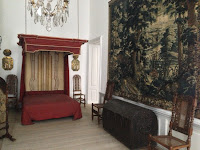In addition to parental labor migration, we also discussed the three main types of immigration: assimilationist/universalist, segregationist, and multiculturalist. An assimilationist perspective would disregard cultural, racial, or religious differences and encourage the immigrant to adapt to the majority culture. A segregationist approach would advocate for "equal" but separate. A multiculturalist perspective believes immigration is a mutual process of adaptation for the host and the migrant. Economic, social, cultural, or political integration - what is most important? There is no standardized way to measure integration because there are many different aspects making it is a personal and individualized process. After writing these four components of integration on the white board around the room, we were encouraged to stand by the one we believed was most important. Although I believe successful integration is measured on an individual case-by-case basis, I was forced to pick one. I decided to stand by social integration because I believe human relationships and a network of support is incredibly important. In my social work education, we are constantly talking about the dynamics and importance of human relationships, so I felt I could most easily backup my claims while recognizing integration is different for everyone.
The plan for the afternoon was to visit the Louisiana Museum of Modern Art. We invited a group of people who had class until 2pm, so we didn't leave until around 2:30pm. Before heading on our way we stopped to get lunch at Joe and the Juice. I've seen this juice shop in several different locations throughout Copenhagen, but haven't actually stopped to give it a try. Joe and the Juice serves fresh squeezed juice and sandwiches, so even though it is a chain store, it is still incredibly healthy. I got an avocado, tomato, mozerella, and pesto sandwich with a grapefruit, passion fruit, and apple juice. It was cleansing and refreshing and I felt ready to tackle the day ahead.

 Kronborg is a few stops past Louisiana Museum of Modern Art which is the castle that was inspiration for Shakespeare's Hamlet. With adventure in our hearts, we headed to the train station to see what our options were and what would be feasible. Never having read Hamlet and without any prior knowledge of what the castle might be like, we made a leap of faith and bought a ticket to the town of Helsingør.
Kronborg is a few stops past Louisiana Museum of Modern Art which is the castle that was inspiration for Shakespeare's Hamlet. With adventure in our hearts, we headed to the train station to see what our options were and what would be feasible. Never having read Hamlet and without any prior knowledge of what the castle might be like, we made a leap of faith and bought a ticket to the town of Helsingør.William Shakespeare's play, Hamlet, is the tragic story of Prince Hamlet avenging the death of his father who was murdered by his brother, Claudius. This play was based on the legend of Amleth and the stories of Saxo Grammaticus in Gesta Danorum which was written in the 13th century.
 We got to Kronborg a half hours before closing time, so we did the tour in record time. We managed to race through the whole castle and the chapel in a little over 30 minutes snapping as many pictures as we could. The castle was built during the time of King Eric VII in the 1420s, controlling the entry to the Baltic Sea. In the late 1500s, King Frederik II later transformed the medieval fortress into a Renaissance castle. On of my favorite rooms was the queen's chamber built the during time of Frederik II for Sofie of Mecklenburg. During the day, sunlight sparkled in the water of a silver fountain and in the evening candlelight glittered in the large brass chandelier reflecting off the gilt ceiling. After the fire of 1629, Christian IV commissioned modern ceiling paintings to replace the carved wooden ceiling and added a new door.
We got to Kronborg a half hours before closing time, so we did the tour in record time. We managed to race through the whole castle and the chapel in a little over 30 minutes snapping as many pictures as we could. The castle was built during the time of King Eric VII in the 1420s, controlling the entry to the Baltic Sea. In the late 1500s, King Frederik II later transformed the medieval fortress into a Renaissance castle. On of my favorite rooms was the queen's chamber built the during time of Frederik II for Sofie of Mecklenburg. During the day, sunlight sparkled in the water of a silver fountain and in the evening candlelight glittered in the large brass chandelier reflecting off the gilt ceiling. After the fire of 1629, Christian IV commissioned modern ceiling paintings to replace the carved wooden ceiling and added a new door.
 Kronborg Chapel was commenced in 1577 during the time of Frederik II. When the castle was handed over to the military in the 18th century, this room was used for fencing, gymnastics, and ammunition storage. In 1840 to 1843, the Chapel was restored and the original furniture returned.
Kronborg Chapel was commenced in 1577 during the time of Frederik II. When the castle was handed over to the military in the 18th century, this room was used for fencing, gymnastics, and ammunition storage. In 1840 to 1843, the Chapel was restored and the original furniture returned.










No comments:
Post a Comment